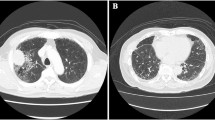Abstract
A 68-year-old male with gastric cancer was treated with tegafur/gimeracil/oteracil and oxaliplatin for 6 months. Thereafter, he was treated with paclitaxel and ramucirumab for 3 months. However, neither regimen had much effect. Thus, he was treated with nivolumab for 2 months, but he developed proteinuria, microhematuria, and an acute kidney injury. A kidney biopsy revealed occasional swollen endothelial cells and proliferating mesangial cells. Few abnormal findings were seen in the tubules or interstitial tissue. Immunofluorescent staining showed segmental immunoglobulin A and complement component 3 deposition, in the mesangial area. Electron microscopy showed a small amount of electron-dense deposits in the paramesangial area and swollen endothelial cells. Mesangial interposition, the loss of endothelial cell fenestration, and subendothelial edema were also observed. Furthermore, foot process effacement and villous transformation of epithelial cells were noted. After the discontinuation of nivolumab, the patient’s renal function gradually improved, and his proteinuria disappeared. Nivolumab treatment was restarted at that time because of cancer progression; however, it was ineffective. No occult blood was detected from 7 months after the administration of the last dose of nivolumab. This is a unique case, in which a kidney biopsy revealed evidence of nivolumab-associated glomerular endothelial injury.



Similar content being viewed by others
References
Champiat S, Lambotte O, Barreau E, Belkhir R, Berdelou A, Carbonnel F, et al. Management of immune checkpoint blockade dysimmune toxicities: a collaborative position paper. Ann Oncol. 2016;27(4):559–74.
Cortazar FB, Marrone KA, Troxell ML, Ralto KM, Hoenig MP, Brahmer JR, et al. Clinicopathological features of acute kidney injury associated with immune checkpoint inhibitors. Kidney Int. 2016;90(3):638–47.
Shirali AC, Perazella MA, Gettinger S. Association of acute interstitial nephritis with programmed cell death 1 inhibitor therapy in lung cancer patients. Am J Kidney Dis. 2016;68(2):287–91.
Spain L, Diem S, Larkin J. Management of toxicities of immune checkpoint inhibitors. Cancer Treat Rev. 2016;44:51–60.
Wanchoo R, Karam S, Uppal NN, Barta VS, Deray G, Devoe C, et al. Adverse renal effects of immune checkpoint inhibitors: a narrative review. Am J Nephrol. 2017;45(2):160–9.
Jung K, Zeng X, Bilusic M. Nivolumab-associated acute glomerulonephritis: a case report and literature review. BMC Nephrol. 2016;17(1):188.
Kishi S, Minato M, Saijo A, Murakami N, Tamaki M, Matsuura M, et al. IgA nephropathy after nivolumab therapy for postoperative recurrence of lung squamous cell carcinoma. Intern Med. 2018;57(9):1259–63.
Mamlouk O, Selamet U, Machado S, Abdelrahim M, Glass WF, Tchakarov A, et al. Nephrotoxicity of immune checkpoint inhibitors beyond tubulointerstitial nephritis: single-center experience. J Immunother Cancer. 2019;7(1):2.
Takahashi N, Tsuji K, Tamiya H, Shinohara T, Kuroda N, Takeuchi E. Goodpasture’s disease in a patient with advanced lung cancer treated with nivolumab: an autopsy case report. Lung Cancer. 2018;122:22–4.
Daanen RA, Maas RJH, Koornstra RHT, Steenbergen EJ, van Herpen CML, Willemsen A. Nivolumab-associated nephrotic syndrome in a patient with renal cell carcinoma: a case report. J Immunother. 2017;40(9):345–8.
Perazella MA, Shirali AC. Nephrotoxicity of cancer immunotherapies: past, present and future. J Am Soc Nephrol. 2018;29(8):2039–52.
Lien YH, Lai LW. Pathogenesis, diagnosis and management of paraneoplastic glomerulonephritis. Nat Rev Nephrol. 2011;7(2):85–95.
Jhaveri KD, Shah HH, Calderon K, Campenot ES, Radhakrishnan J. Glomerular diseases seen with cancer and chemotherapy: a narrative review. Kidney Int. 2013;84(1):34–44.
Yamada R, Okawa T, Matsuo K, Suzuki M, Mori N, Mori K. Renal-limited thrombotic microangiopathy after switching from bevacizumab to ramucirumab: a case report. BMC Nephrol. 2019;20(1):14.
Cassol C, Satoskar A, Lozanski G, Rovin B, Hebert L, Nadasdy T, et al. Anti-PD-1 immunotherapy may induce interstitial nephritis with increased tubular epithelial expression of PD-L1. Kidney Int Rep. 2019;4(8):1152–60.
Author information
Authors and Affiliations
Corresponding author
Ethics declarations
Conflicts of interest
The authors have declared that no conflicts of interest exist.
Ethical approval
All procedures performed in studies involving human participants were in accordance with the ethical standards of the institutional and/or national research committee at which the studies were conducted and with the 1964 Helsinki declaration and its later amendments or comparable ethical standards.
Informed consent
Informed consent was obtained from the patient in this study.
Additional information
Publisher's Note
Springer Nature remains neutral with regard to jurisdictional claims in published maps and institutional affiliations.
Supplementary Information
Below is the link to the electronic supplementary material.
13730_2021_610_MOESM1_ESM.png
Supplementary Fig. 1 Immunohistochemistry performed with PD-L1 antibodies. a: PD-L1 staining of the tubular epithelial cell membrane (PNG 902 kb)
About this article
Cite this article
Shim, J., Tochio, A., Ueda, N. et al. Nivolumab-associated glomerular endothelial injury in a patient with gastric cancer. CEN Case Rep 10, 576–581 (2021). https://doi.org/10.1007/s13730-021-00610-0
Received:
Accepted:
Published:
Issue Date:
DOI: https://doi.org/10.1007/s13730-021-00610-0




